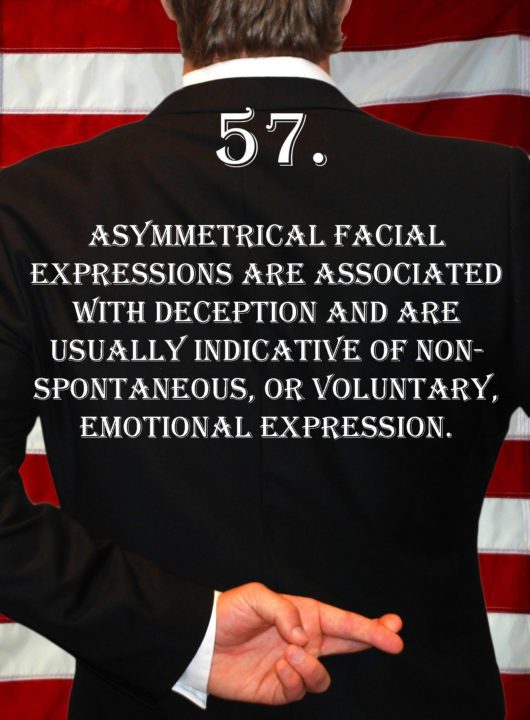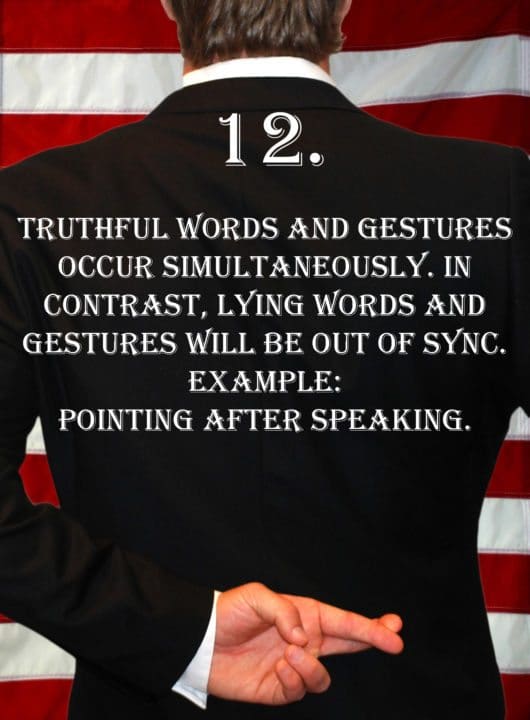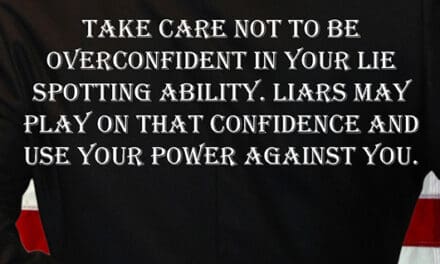
Deception Tip 57:
Asymmetrical facial expressions are associated with deception and are usually indicative of non-spontaneous, or voluntary, emotional expression.
Listen To The Podcast!
E57 – Asymmetrical Expressions – Deception Tips Podcast – Click Here To Subscribe
Podcast Transcript
Hello and welcome to the Deception Tips podcast where you will learn amazing cues to detect deceit that will help you read people like never before. I’m your host Spencer Coffman, let’s get started.
Welcome to episode 57 of the Deception Tips podcast. Last time, we talked about a deception tip that was a three-in-one tip, it was combined. It encompassed a few different tips that we talked about long ago, they were ‘Locking the Ankles’, ‘Crossing the Legs at the Calf Muscle in the Form of an X’, and also ‘Backing Away’, so if you don’t remember those, take a listen to them.
You can also check out the deception tips videos on the Body Language YouTube channel to get a little bit more information about them because they are very important.
So, ‘Locked Ankles’ was episode 22, which would also be deception tip 22 or video 22, so it is pretty convenient for you that they are all the same. ‘Stepping Backward’ was episode 29, again same as video 29 or deception tip 29, and then ‘Towards the Exit’ was episode 50 or deception tip 50.
So, listen to those, get a good idea of what they are then if you need to listen again to episode 56, be sure to watch the video, read the deception tip because then you’ll have an idea of how those three fit together to form a new tip. Remember, it isn’t really a pattern or a cluster of behaviors because they are all in the same area, it’s all happening together as one fluid movement.
Therefore, it’s not like it is multiple behaviors happening independently of each other combining to make a pattern or cluster of behaviors. A cluster is separate behaviors happening within the same region or similarity proximity to each other. It’s like one thing then maybe a little bit later in the conversation another thing then another, it’s not all at the same time.
Whereas this behavior, the ankles backing away, when someone locks their ankles, they tuck their feet under their chair, they’ve got their calf muscles crossed in that X, that’s all happening together at the same time, which means it’s not considered a cluster.
If you saw that with the arm folding, the hunching of the shoulders, and then leaning back, that could be a cluster because that’s two separate behaviors. Even though the arm folding, hunching the shoulders, and leaning back that’s three behaviors, again just like the feet where it’s all happening simultaneously, it’s all happening on the arms together.
Therefore, it is not a distinct cluster or a pattern of behaviors, it’s one gesture, one behavior, so keep that in mind, and be on the lookout for that. Always look for those patterns and clusters of behavior so you will be able to know when they’re happening versus when it’s just a singular behavior and what they mean, that’s also important.
Today, we have another expression, this one is more closely related to the face and it has to do with expressions of emotion and how these expressions are situated on the face and in what orientation they occur. It is similar to some that we’ve talked about before, way back in episode 14, where we talked about ‘Symmetrical Expressions’ and how facial expressions need to be symmetrical on the face.
That means they need to be both on the left and the right, they should happen equally or symmetrically across the face. Like that cartoon thing in the coloring books where they draw half and then you use the grid paper to draw the other half, symmetrical expressions.
Then we also talked about, in episode 16, ‘Symmetrical Gestures’, that gestures should be symmetrical with each side of the body like a shoulder shrug should happen on both sides. We’ve also talked a lot about different things with simultaneous gestures, that was in episode 12.
We’ve talked about different things like contradictory behaviors in episode three. There are a lot of similar things with deception and how they should be congruent and symmetrical, and they can’t be asymmetrical or contradictory, things like that.
Today, we’re talking about asymmetrical expressions. If truthful expressions must be symmetrical then by reasoning, if you see an asymmetrical expression, it’s probably going to be false or nontruthful.
So, here it is, this is deception tip number 57. Asymmetrical facial expressions are associated with deception and are usually indicative of non-spontaneous or voluntary emotional expression. Here it is again, deception tip 57. Asymmetrical facial expressions are associated with deception and are usually indicative of non-spontaneous or voluntary emotional expression.
So, what does this mean? There’s a lot there and there are a lot of big words. Well, don’t worry because it’s really simple, asymmetrical facial expressions, which means that they’re not the same on both sides of the face.
So, if you have an expression that’s not the same on both sides of the face, remember we talked about how expressions on the left side of the face with the asymmetricality, that was in episode 23.
If they are more on the left side, it’s more truthful, right brain, left brain, how they coordinate with each side of the face and the body. They are contralaterally related and which side of the brain is more prominent in deception, remember it is the right side of the brain.
Then remember that contempt, in episode 19, is the only asymmetrical expression that is truthful. So, we’re going to dive a lot more into this sign and a lot more into all of the recap, and a lot more into symmetricality and asymmetricality coming up right after this.
Would you like to know if you are being lied to? Lies are everywhere and they could be happening to you. “A Guide to Deception” is a great book filled with information on how to spot lies. Get your copy today online at spencercoffman.com.
Welcome back to deception tip 57, here we are talking about symmetricality and how asymmetrical expressions are mostly associated with deceptive behaviors or deception. Usually, when something is asymmetrical then it is false, or it is voluntary emotional expression. Symmetricality goes the same with facial expressions and with body language, so remember that as well.
So, here we go, asymmetrical facial expressions, that’s what we’re talking about, they are associated with deception. It’s usually indicative of the non-spontaneous, remember spontaneous is something that can’t be controlled, it just happens on the spot, spontaneous on the spot. So, when someone slams a book shut and everybody jumps in a little bit of fear, startled surprise, that is a spontaneous expression.
If someone slammed the book shut and a couple of people jumped and then later someone else jumps, that would be a non-spontaneous, they faked that. It’s voluntary, they volunteered that expression forward, it’s fake, it is not real emotion or not a real reaction, so usually, those would be asymmetrical, why? It is because they’re fake.
Remember, the left side of the brain controls the right side of the body and the right side of the brain controls the left side of the body. Also remember that when people engage in false emotion, it is something that they are doing voluntarily, it is a lie, it is a deception. So, it’s not going to be symmetrical or fluid and in addition, they’re going to last longer.
Therefore, one side of the brain is more prevalent in deception than the other side of the brain. This usually means that you’re going to see it more on one side of the body. Therefore, watch the left side because remember, if the left side is more expressive than the right, it may indicate false emotion or deception. This is because the right brain is more prevalent in deception or being false or deceptive emotions.
Remember that the right brain is that creative or artistic style, so they want to concoct the stories of fain different emotions. Whereas the left side is more rules and rigid and set structure, and language, they’re not going to be lying on the left side.
The left side will control the right side of the face, so if you see the left side of the face more active then watch out for the deception because the right brain is more active in deception.
So, that asymmetrical facial expression that you see is most likely going to be occurring on the left side of the face. Remember the right side of the face will also even out because it’s the whole conscious that wants to make sure that it looks real, so it’s going to be a little bit more prevalent on the left side. You may see it there first, it may finish their last just like a smile.
When you see someone faking a smile, they may start to smile more on the left side, right side comes up to equal it out then when it goes away, it goes away first on the right side then it comes down on the left. That left is trying to push out there that the smile is truly real, so remember that’s asymmetric, it’s false. So, watch out for these asymmetrical expressions on more of the left side of the face.
In case you don’t remember, we talked about the left side, we had a whole episode on that, a whole deception tip on that. There’s a video and then in the book as well, ‘Deception Tips Revised and Expanded’ and then also just the regular Deception Tips, you can grab them anywhere on my website, spencercoffman.com.
Anyway, episode 23 was the one where we talked about the left side of the face, so you’ve got a lot of recaps to do to listen to all these things. We’re in a big thing of symmetricality, we’ve talked a lot about congruent gestures, symmetrical gestures, asymmetrical gestures, and simultaneous gestures, so that’s a lot of stuff, we had contradictory behaviors.
I’m going to make this a little bit simpler for you, if you go on YouTube, on the Body Language YouTube channel, I will put all of these that are related in playlists. So, you can watch a series of videos that are all related to symmetricality, and asymmetricality, which will greatly help you out. Then you can go take a look at the numbers, go over the podcast, and listen to that podcast episode.
You’ll really understand what is going on with all of these different things that are related to each other, so that will be very helpful for you, I encourage you to do that. Continuing on, asymmetrical facial expressions, could be with any sign of emotion or deception. Somebody wants to pretend they’re happy, they smile, somebody wants to pretend they’re sad, they’re going to frown.
Where do you think the frown is going to be more prevalent, right or left? Hopefully, you said left because remember the right side of the brain is associated with deception. Keep going, things like contempt, where do you think that would be more prevalent? Contempt is the only truthful asymmetrical sign of body language, so it is a truthful sign, it is emotion, it is coming out, it is contempt.
If contempt is truthful, let’s follow some reasoning, contempt is truthful, it is asymmetrical. The right side of the brain is more prevalent in false emotions, so the left side of the brain would be more prevalent in truthful emotions there for contempt in being truthful, should be more dominant on the right side of the face because it is controlled by the left brain, which is more truthful.
That doesn’t mean you won’t see contempt on the left side of the face. However, if you see it on the left side of the face, consider that it could be a false form of contempt or it could be something else. That’s something to consider, it’s a little wrench in your plan and is really the only one you need to remember for asymmetricality. Otherwise, you remember, everything is asymmetrical, false, contempt, true, only asymmetrical one.
Therefore, if you remember that you’ll be set, you’ll be fine, in addition, pay attention to yourself. When you notice things happening on your face, you notice a half-smile, is that contempt? What were you thinking? What happened? Did someone do something stupid or say something stupid and you’re like whatever man and you gave a sign of contempt?
Almost like an eye roll, that’s about what contempt is, it’s the feeling of superiority is better than, it’s an eye roll but it’s an eye roll of the face and it’s a little bit more extreme than an eye roll. If you see it on someone, you want to pay attention and be like, whoa, what’s going on? Why don’t they like me? What am I doing to make them so disgusted with me? It’s almost like disgust, it’s a precursor.
So, pay attention to that because that is important, especially if you have employees and you’re seeing it on your employees. You may need to have a conversation with one of those employees if you’re starting to see contempt because that’s a serious deal.
So, back to this, watch out for the asymmetrical facial expressions because they are a sign of false emotion and deception that you will want to pay attention to so that you know that you are not being lied to, you want to make sure that you are getting the truth.
So, I want to thank you for listening to this week’s episode of the Deception Tips podcast. I hope that you’ll share it with your friends, subscribe to the feed, check out the deception tips videos, and the blog, and also take a look at the books I have available as always, tune in next week for a new deception tip.
Video Transcript
Hey guys, my name is Spencer Coffman, thank you for watching the deception tips videos, they’re all about teaching you how to read people and detect deception so that you will be able to tell if someone is lying to you. Today, we are talking about an overall body language sign that you can see and realize whether or not someone is telling the truth, whether they’re being deceptive or truthful and situations like that.
This one, as I said, it’s the whole body, so it has to do with symmetrical expressions and asymmetrical expressions. How the different gestures and body language signs are displayed on our bodies, in our speaking, in our habits, and the way that we move and talk when we are speaking. So, this one is about gestures being asymmetrical and when they’re asymmetrical they’re generally false.
Most of the time when people are truthful their brains are communicating simultaneously, their brains, as if they have two brains, but really, it’s each hemisphere of the brain. They are communicating with each other so that these gestures are happening simultaneously on both sides of the body.
So, here it is, this is deception tip number 57. Asymmetrical facial expressions are associated with deception and are usually indicative of non-spontaneous or voluntary emotional expression. So, this one is a little bit confusing in that it has a lot of big words, asymmetrical facial expressions, so what does that mean? It means that a certain expression happens on one side of the face more than on the other.
If you remember Contempt, which was deception tip number 19, that is the only asymmetrical facial expression and you’ll see it on one side of the face more than the other. The reason is because contempt is one of those things that doesn’t need to be, it’s not on both sides of the face, so when you see it, it’s only one-sided but it is truthful.
All of the other expressions or gestures, if you watch my hand gestures throughout this video, they are happening together. They’re simultaneous and congruent, they’re symmetrical, they’re happening on both sides of the body, and they are happening with each other, with my speech in simultaneous synchronization with everything.
They are truthful, why are they truthful? Well, in the brain, we have two hemispheres, one is the right, one is the left, so each side of the brain is contralaterally related to the opposite side of the body or that side of the body. So, the right brain controls the left side, the left brain controls the right side, just like that.
When they are communicating effectively and truthfully then it is spontaneous, emotional facial expressions are happening in that instant. The gestures are happening spontaneously, they’re not planned, they’re not faked, they’re not happening without the spontaneous expression, they’re just instant. It’s just like that when you saw me move, I didn’t plan that it wasn’t like I rehearsed that, it wasn’t something that I had to practice, it just happened, it was natural.
Therefore, the brain is communicating as one, each side of the brain is sending out signals to each side of the body in a fluid motion so that these expressions on my face and these gestures on my body can all happen simultaneously and symmetrically. If you remember, there is one side of the brain that is more active in deception and we talked about this in deception tip number 23.
We said that the right brain is more active in false emotion or fake emotion deception. We talked about smiles if you don’t remember any of that I encourage you to check out that tip, just re-watch the video or listen to the podcast. One side of the brain is more prevalent in deception which means that you will see that asymmetricality more displayed on one side of the face than the other.
It will more typically be on the left side of the face because if it’s the right brain that is more in deception then it would be on the left side of the face that you would see this asymmetricality happening when someone is either speaking or gesturing. Whether it’s a facial expression of emotion or whether it is something on their body language or gestures.
We have a number of tips that we’ve talked about with symmetricality, with the hemispheres of the brain and which side is predominant, with simultaneous gestures, with speech, with facial expressions and body language all being congruent or symmetrical or asymmetrical. So, I encourage you to check out the playlists of all those videos, I’ve combined them all for you, you can just watch them all and get an idea of it.
Also, if you don’t remember anything about it all, here’s a little recap, basically, if expressions on the face or gestures on the body are simultaneous, congruent and symmetrical then they are true, they’re real. If they are asymmetrical or they don’t match up with speech, they’re incongruent, they’re not simultaneous then they are generally false, they’re fake. Keep that in mind, use that as your general rule of thumb and pay attention to other signs and behaviors as well.
If this is your first time watching these videos, I’d love to have you subscribe to the channel on YouTube, feel free to comment with any questions you may have as well. Also, if you’d like some more information, we have books, blog posts, and podcasts, all available on spencercoffman.com that are dedicated to teaching you exactly what every body is really saying.
Until next time.






